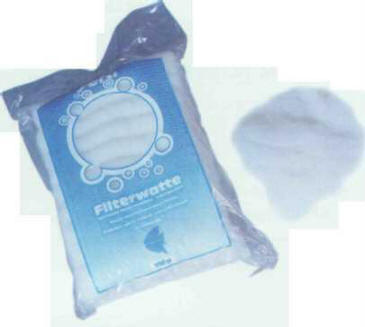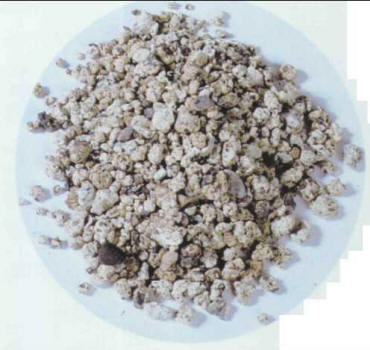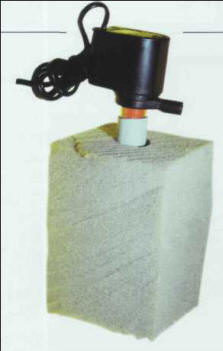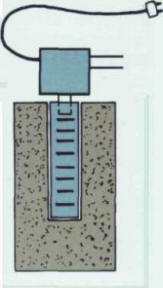USES VARIOUS FILTERING MEDIA
The filtering materials can be either natural - gravel, sand, clay, active carbon,
peat, crushed oyster shells, rocks - or artificial - PVC, foam, Perlon, and various
plastic materials.
Different materials correspond to specific functions.
For a coarse filtration, use gravel, rocks, sand, clay, or large pieces of PVC.
A fine filtration requires fine sand, foam, or Perlon; a biological filtration,
sand, foam, cotton, or clay. Peat, active carbon, crushed oyster shells, or calcareous
rocks are effective materials for exerting a chemical action.
With the exception of the last category, a filtering material must be chemically
neutral, i.e. it must not modify the main characteristics of the water (pH, hardness,
or density).

All the filtering media of variable volume (gravel, sand, earth, clay) are easier
to handle if they are placed in a fine-meshed pouch (made from a net curtain or
tights, for example).
Gravel and thick sand
These are used as pre-filtration media to trap the largest pieces of debris,
especially in the external filters. They are being increasingly replaced by artificial
material, but fairly thick sand (grains of 2-3 mm) are still required in freshwater
undergravel filters.
Lava rocks

Lava rocks provide a good bacterial support.
These rocks, broken into pieces of various sizes, play a double role: mechanical,
for suspended matter, and biological.The form and surface of the rocks encourage
the presence of bacteria, as well as good water circulation of water.
Oyster sheik and calcareous rocks
These play the same role, but also release moderate amounts of calcium carbonate
into the water going through them. They are therefore used to maintain a high degree
of hardness in some types of tanks, such as regional East African aquariums, for
instance.
They must be pounded and crushed, and then rinsed carefully, in order to eliminate
the fine particles produced.
Clay
Clay, in the form of balls of a few mm to 1 cm in diameter, provides a good bacterial
support. It is rarely used on its own, but rather as a complement to another material,
to ensure pre-filtration.

Balls of clay can be used for pre-filtration.
Peat
Peat (see page 16) is placed in a filter to acidify the water passing through
it; therefore, its main role is not filtration, although it can trap some particles.
It is used in fresh water to obtain the low pH required to keep and reproduce certain
species. Be aware that peat turns water an amber yellow color.
It is, therefore, not at all advisable to apply peat designed for horticultural
use, as it contains substances that can be dangerous in an aquarium. Suitable peat
is commercially available, although you will have to proceed by trial and error
and do some tests before finding the quantity needed to maintain a specific pH.
Active carbon
Active carbon is obtained by calcining (burning) vegetable matter under very
precise conditions. It is a very porous material with properties useful to fishkeepers.
It fixes organic coloring substances, which makes it possible to obtain really clear
water. It also fixes some medicines, especially those based on colorants. In this
case, a filter is only used to eliminate a medicine, once the treatment has been
completed. What is more, active carbon traps smells. Its main deficiency is that
it loses these distinguishing properties quite quickly. It offers a good support
for bacteria, but no more so than other more practical filtering media.
To sum up, active carbon is a material with very specific applications, to be
used only in fresh water and not in sea water, and it must be rinsed in warm water
before use.
Perlon

Perlon retains fine particles. It is an easy material to
use.
This artificial material comes in the form of intertwined filaments. Be careful:
it must not be confused with glass wool, which is highly unsuitable for aquariums,
as it can release tiny fragments into the water. It is generally used in association
with foam as the first filtering material, especially so in box and wet-dry filters.

There is a very w/de range of filtering materials; often
the most desirable is the one offering the largest surface area for trapping bacteria.
Foam
This synthetic polyester foam has open pores, like that found in mattresses or
cushions. This material is very fashionable in the aquarium trade these days and
it seems to offer nothing but advantages: it is light, neutral, easy to handle and
cut, as well as being cheap. Furthermore, it provides a highly effective bacterial
support, and is also excellent for mechanical filtration. The foam generally used
has a density of 20 kg/m-\ and its porosity is ideal both for retaining suspended
particles and for allowing bacteria to develop. Generally speaking, the experience
of a great many aquarists and public aquariums has shown that a thickness of 8 cm,
divided into two more or less equal parts for easier upkeep, is usually sufficient
for filtration.lt is possible to find some commercially available, or else home-made,
filters entirely composed of foam - small internal filters or external filters,
both box and wet-dry - and these are also completely satisfactory.
Various plastic-based materials
Different types of plastic material, such as PVC, can be used to make the filtration
or pre-filtration elements: small pieces of pipe around 1 cm in diameter, balls,
cubes with an openwork design, etc. The list is endless, and contains not only items
found in the aquarium trade but also recycled domestic materials.
Combinations of filtering media
When several filtering materials are found in the same filter, the water must
successively pass through materials decreasing in grain size. The coarsest materials
serve as a pre-filter for large pieces of debris, while the others retain the finer
particles. All these filtering media enhance the development of bacterial colonies
that convert nitrogenous products, with pride of place being taken by foam and clay
balls.

A pump, a PVC pipe with slits down the sides, and a block
of foam make up a filter that can be quickly put into operation.
Cleaning the filtering media
The filtering media p r o g r e s s i v e l y accumulate particles, at a rate
depending on granule size, the speed at which the water flows through them and finally
the amount of suspended matter it contains. When they are saturated, they can be
cleaned with warm tap water, without any detergent or soap, until clear rinsing
water is hence obtained.

Cleaning the filtering media
Aquarists who have several tanks wash several pieces of foam together in a washing
machine, though obviously without any washing powder. It is unfortunate that cleaning
eliminates the large majority, or indeed all, of the useful bacteria. The filter
will therefore be effective for particles but will no longer be able to play any
biological role. To alleviate this problem, you can clean only half the filtering
media each time: the bacteria living in the unwashed part will be sufficient to
purify the water and will quickly recolonize the other half. If you are using two
filters, you can, of course, clean one at a time. If the aquarium has to remain
empty, in the meantime the filtering media can be put into the filter of another
aquarium, and in this way they will still collect bacteria and can quickly be put
back into service. It is vital not to interrupt the nitrogen cycle in a biological
filter, as this may give rise to toxic compounds.
MAKING A FOAM FILTER IN AN EMERGENCY
The sucking nozzle of an electric pump is extended with a pipe - PVC or semi-rigid
plastic, such as a garden hose - with a series of slits down the sides. This is
inserted into a block of foam with the center already cut out with a knife or blade.
The water has to pass through the foam, before being taken in through the slit pipe
and returned to the aquarium. This quick and easy filter works well when improvisation
is called for to keep an aquarium in operation.

|